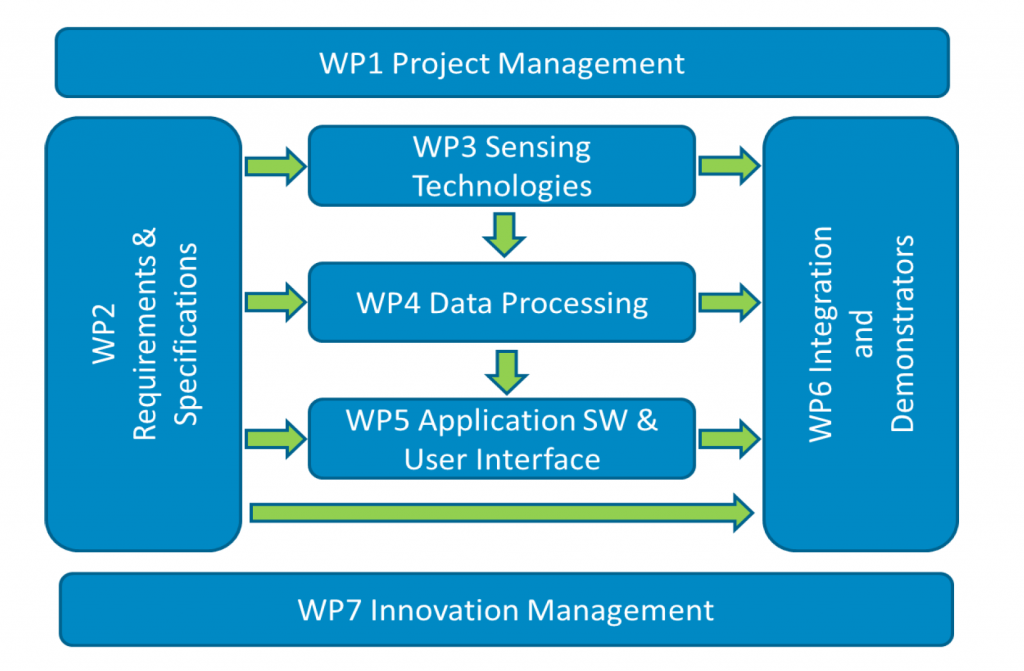The ASTONISH project consists of 7 work packages that are categorized as follows:
– One work package (WP2) is related to state of the art analysis, requirements analysis and system specifications.
– Three work packages (WP3, WP4 and WP5) provide the technology components of the project. The activities in these WPs involve research, technology and development activities.
– One work package (WP6) is concerned with the integration of the technology components from WP3,4,5, including the demonstration and validation.
– One work package (WP7) will focus on the dissemination, communication and exploitation of the project’s results.
– One work package is dedicated to Project Management, addressing the alignment of work packages, managing the overall project and the interaction with the public authorities and ECSEL office.

WP1: Project Management
WP objective: Overall coordination and project management
In WP1 the overall project will be coordinated and work will be aligned between work packages. Day to day management according to the consortium agreement is coordinated through the Project Management Team. WP1 will also initiate and manage the yearly progress reports. The project leader will act as the primary contact to the commission with respect to legal, financial and administrative tasks.
WP2: Requirements and Specifications
WP objective: Tracking and updating of the state of the art (SotA) from the project start; comparison of project results with SotA; update of system requirements (therein including both hardware and software) compared to the SotA.
The aim of this WP is to provide a detailed update on the state of the art in order to better define the advances the Consortium will produce within the project timeframe. The minimum system requirements and specification will also be targeted within WP2.
A careful comparison of the SotA and the new technologies improvements will be performed, including technical aspects (better performances) and the other advantages that the new technologies will bring to the community. Non limiting examples are: time for analysis (fast tests, reduced hospitalization times, reduced physician time dedicated to both the analysis and the diagnosis); diagnoses accuracy (more data available); analysis level (hospital, surgery, point of care, …); personalization of the treatment; possibilities to promote prevention campaigns; patient quality of life, comfort, and side effects.
WP3: Sensing technologies
WP objective: Development of breakthrough optical sensing technologies for advanced health monitoring
The technology development and characterization activity done in the framework of WP3 will deliver breakthrough optical sensing technologies with enhanced detection capability. More particularly the work will focus on the development of calibrated light sources, suitable imaging optics, tunable and micro-patterned optical filters and ultra-high sensitive optical detectors and hyperspectral imagers operating in visible and infrared wavelength ranges. Dedicated front-end electronics will be developed for detectors signals processing to further optimize the performance of the sensing systems.
WP4: Data Processing
WP objective: Develop algorithms and implementations of data processing components.
WP4 is dedicated to signal processing and image processing. This involves sensor related processing to improve the data quality, spectral analysis, feature extraction, pattern recognition and classification, multi modal processing and fusion. The purpose is to enhance the signal quality coming from the sensors in WP3 and to extract relevant data that can be used in visualization tools in WP5.
WP5: Application SW and User Interface
WP objective: Any medical services developed in the ASTONISH project need to be used by doctors, they need a friendly graphical interface not only to see the data also to understand the information.
This work package will cover the software development that enables the data exchange and communication between the sensor system and the use. Although the specific objectives will depend on the type of sensing and the clinical use of the imaging or sensing system, varying from interaction tools with surgical items to display information and navigation over information in the surgery process, to a graphical system that helps to the clinical staff in the diagnosis of skin cancer process, all developments must considering matters like integrity, interaction time, privacy etc.
WP6: Integration and Demonstrators
WP objective: Integration and demonstration of project results and validation.
The objective of WP6 is to integrate, demonstrate and validate the technologies that are delivered by WP3, WP4 and WP5. For the validation part, it will take into account the requirements that have been defined in WP2.
Although the application tracks have common needs for NIRS, hyperspectral imaging or multimodal processing, specific demonstrators will be realized to ensure that the components delivered in this project will fulfill the specific application requirements.
WP7: Innovation management
WP objective: To disseminate and communicate the project results and plan exploitation of the projects results.
